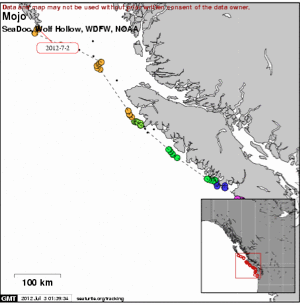rehabilitation
Newborn seal pup taken to rehab
Jul/25/20 01:04 PM
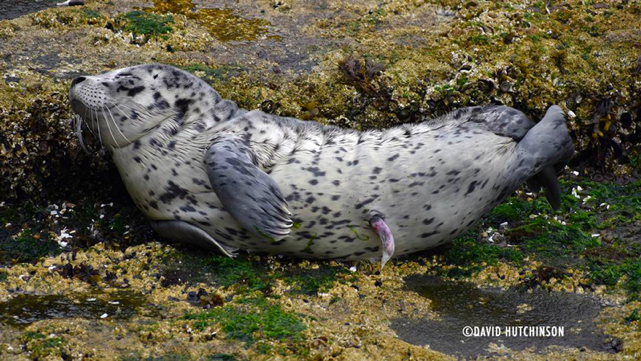
First Responder Jay immediately headed to the site, armed with stranding materials if necessary to keep people back. Upon arrival, he saw a short stub of umbilical cord on the alert pup’s belly. He notified other responders that we had a newborn seal on our urban beach - a scenario that often has a bad outcome. Abandonment is much more likely when people or dogs cause disturbance and frighten a mom away. If a mom has not bonded with her newborn or fears for her own safety, she may not return to nurse the pup, who cannot survive without her.
For the past 5 months, NOAA’s Marine Mammal Stranding Networks have been trying to determine how to respond to and protect animals while abiding with safety considerations and distancing mandates in these COVID times. Seal Sitters’ response area has miles of urban shoreline, almost all accessible to the public for recreation purposes. During this difficult time, our responders have been deliberating the logistics of giving seal pups the protection and rest they need, yet keeping our volunteers and the public safe - all the while trying to keep people at a distance, not only from the pup, but also from each other and discourage assembly. A heady challenge.
That challenge was put to the test Wednesday morning. A quick perimeter of yellow tape emblazoned with “Share the Shore” was established on the sidewalk above the pup and cones were placed on the beach. Fearing that the pup might already have been abandoned, a call was placed to PAWS Wildlife Center to see if they had an open space to accept the pup if necessary. The answer was yes. A second call was made to SR3, a valued non-profit which provides support to the stranding networks. Arrangements were made for their vet to do an on-site visual evaluation of the tiny seal. Based on the length and color of the umbilical cord, the pup was likely only a day old.
Since the seal was alert and assessed to be in relatively good body condition, the decision was made to maintain a low-key volunteer presence to ensure her safety onshore, in hopes the mom might return sometime during the day - or, more likely, in the evening when human activity had quieted down. A pup’s best chance for survival is always with mom. While rehab can fatten up a pup in a small pool, robust enough to be released back into the wild, it cannot teach a pup life skills and how to hunt in the vast waters of Puget Sound. The plan was to capture the pup for transport if the pup’s health declined during the day or if she was still onshore the next morning.
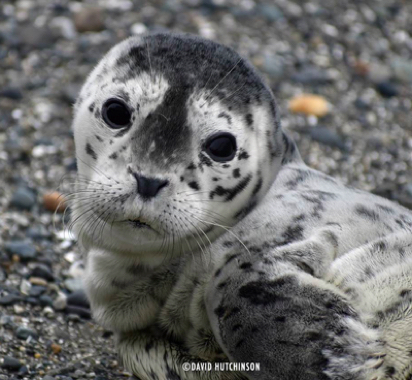
At 5pm, with an ever-encroaching return tide, Echo was forced into the cold waters of Puget Sound. She paddled along the edge the sea wall, trying several times to haul out again, but finally gave up and swam straight out, away from the beach.
Later, she came ashore right in front of the Alki Bathhouse. Resting only briefly after having struggled in the surf, the incoming waves swept over her once more and the exhausted pup again took off. Volunteers scanned the waves, but here was no sign of an adult seal waiting anywhere offshore.
Shortly after 8pm, the hotline received a frantic report that people were throwing rocks at a pup at the end of the public promenade. Seal Sitters arrived within minutes and Echo was already swimming west toward private beach, inaccessible to responders because of the high tide. We guessed that she likely ended up in a particular nook just on the other side of a cement bulkhead. We were optimistic that little Echo might find some peace and rest there for the night, but less optimistic that mom was still around to feed her.
Sure enough, early the next morning the homeowner phoned Seal Sitters Hotline (206-905-SEAL) to say that Echo was on his beach. Based on deteriorating body condition, indicative of the absence of an attending mom, the decision was made to take her to rehab. Echo was captured and transported by SR3 to PAWS rehabilitation facility in Lynnwood.
PAWS reports that the female pup weighs almost 20 pounds and is just under 30 inches long. At intake, Echo was thin and dehydrated, but the hope is that she will do well in rehab. Seal Sitters thanks PAWS for giving this stunning silver pup a chance for survival. A heartfelt thanks goes out to SR3 for their field support and to Seal Sitters’ First Responders and volunteers who protected Echo throughout a long, stressful day.
Seal pup captured at last and taken to rehab
Apr/30/17 08:34 AM
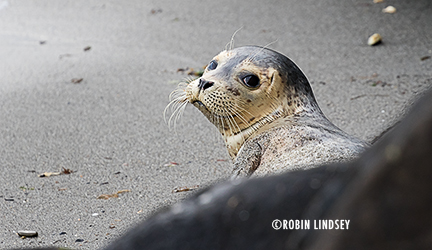
Taffy showed up earlier than expected on Saturday morning, well before her favorite triangular rock was exposed by the waning tide. First Responder Robin was down on the early side, coffee thermos in hand, just in case the little trickster needed an earlier rest. She peeked over the sea wall and lo and behold, the silvery pup was already tucked into a nook between the large charcoal-colored boulders.
While extending the tape perimeter on the beach, a text was sent to the usual Taffy early morning crew of Lynn, David, Nicole and Buzz with the message “Taffy onshore now!” Nicole stopped by, but was on her way to work. Just in case we needed volunteers for the day, Volunteer Scheduler Denise was notified, who checked the online calendar and started dialing. As soon as Lynn arrived, Robin realized the fleeting opportunity to capture the pup was finally here - NOW. Taffy was in the perfect position behind a rock, about 5 feet from the water, and there was no time to wait for help; she could crawl out into full view in minutes and we would have missed our chance yet again. Thankfully, due to the early hour and overcast, the surrounding area was not yet busy with walkers and runners.
Lynn and Robin grabbed the net and kennel from the car, donned heavy gloves and scrambled down onto the sandy beach. Creeping in and out along the base of the sea wall, crouching behind rocks so Taffy couldn’t see their approach, they inched closer to her. Finally, swinging out onto the open beach, they managed to get a pole net on her just as the pup saw them and bolted for a getaway.
As soon as the Taffy was secured in the net, Lynn dashed back down the beach to grab the kennel.
Now, the real fun began as the responders fought to get a biting, wriggling, strong and not-so-happy older and bigger seal pup transferred from the large salmon landing net into the kennel without injuring Taffy - and not losing a finger or arm in the process. After a few hair-raising minutes, she was latched inside the kennel. Robin caught the attention of a man walking up along the sea wall. Bill enthusiastically jumped down to help lug the kennel across the sand, back up and over the high wall and into a car for transport to PAWS Wildlife Center in Lynnwood for stabilization, assessment and, hopefully, rehabilitation.
Thanks to those Seal Sitters responders and volunteers who did their best to protect Taffy over the course of 4 weeks at a busy urban location. It was a challenge to keep her safe from off-leash dogs, especially as her health declined and her haul-out schedule became more unpredictable. Thanks also to all the caring folks who stopped by almost daily to inquire about her.
PUPDATE
4/30 morning: We are awaiting further information from PAWS after a more extensive veterinary exam is performed today, but the good news is that Taffy has been stabilized with fluids. She has a number of issues, including her flipper wounds (see earlier posts).
Thanks to PAWS’ dedicated staff for treating Taffy. We will keep you posted as we learn the cause of periodic bloody mucous from the mouth and coughing (likely lungworm infestation) and her numerous health concerns.
Seal pup Hope thriving in rehab for return to the wild
Feb/19/17 06:17 PM
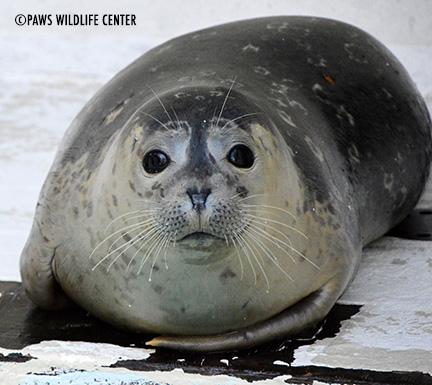
A very chubby Hope, markedly more robust than when captured, is shown at right, resting poolside at PAWS Wildlife Center.
Upon capture by first responders, the small female was covered in bite wounds - 22 in all - from an unknown animal (see photo below). Thankfully, the punctures were not deep and infected.
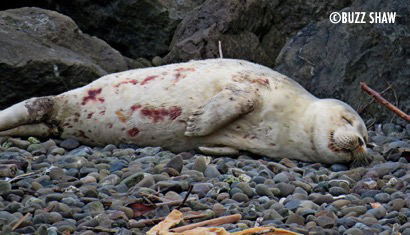
Hope was soon moved to her very own outdoor pool, gradually packing on weight and a thick layer of blubber which will keep her warm and sustain her while she adapts to life back in the wild.
Bittersweet news about West Seattle seal pups in rehab
Feb/06/17 01:19 PM
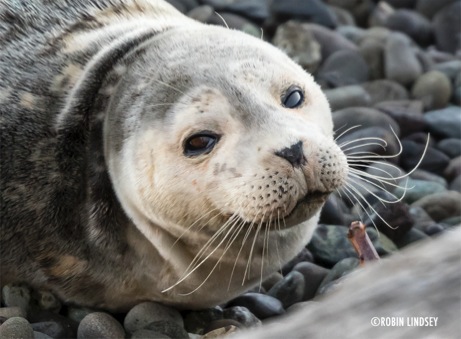
We’re elated to report that female seal pup Hope (shown at left, before capture near the Water Taxi landing) is gaining weight and doing pretty well overall.
Hope’s body was riddled with over 20 bite wounds, from an unidentified animal. Barring any unforeseen health issues, she may be released back to the wild waters of Puget Sound in a couple of weeks. That is great news about her new lease on life!
On a very sad note, Wild Thing, the thin male pup rescued by Seal Sitters first responders near Lincoln Park’s Colman Pool on January 21st, took a turn for the worse and died ten days later. In addition to two infected “animal bites” on the chest, Wild Thing’s “guardedly cautious” chance for recovery was compromised by a number of issues. WDFW Marine Mammal Investigations Unit will be performing a necropsy and we will update you with their findings.
NECROPSY FINDINGS
A necropsy by WDFW Marine Mammal Investigations revealed that Wild Thing most likely died from a systemic bacterial infection from a chest wound. Additionally, the pup had a drastically thin blubber layer.
Injured seal pup rescued from Lincoln Park beach
Jan/21/17 03:53 PM
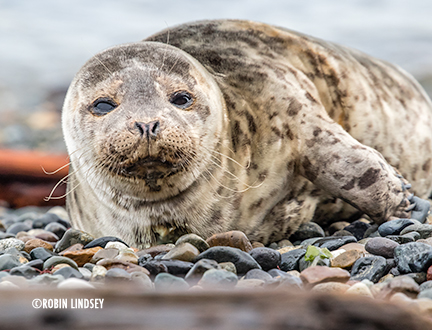
The pup captured this afternoon is the same pup that has been using the shoreline near Lincoln Park’s Colman pool the past couple of days. The pup was first sighted on the pebbled beach early Thursday morning (see post below) and again late yesterday afternoon, just before dark. Both times, the pup returned to the water after resting briefly onshore.
Early this morning, the hotline received a call about a pup hauled out a few yards from Seal Sitters’ permanent signage, posted just north of the public pool. When First Responder Robin arrived, concerned residents, including the reporting party, were standing guard over the alert pup, in the driftwood just feet from the paved pathway. The three women enthusiastically helped stretch tape and signage to provide a safety zone, closing it off to entry and disturbance.
Volunteer scheduler Lynn scrambled to line up volunteers. So many were attending the Women’s March in downtown Seattle today that the online calendar was bare. First Responder Dana came down to lend a hand. Before long, volunteers Jennifer, Elissa, and Buzz arrived to pass out small info handouts and inform passersby that resting out of the water is normal behavior for all seals. Kids were given seal stickers that were promptly stuck on bike helmets and jackets.
Photos taken with a telephoto lens revealed a severely infected wound on the throat of the pup. The images were sent for review to a consulting vet and plans were subsequently put into place to capture the pup and transport for treatment.
First Responder Lynn arrived with capture supplies. Because the pup was positioned so close to the water’s edge and was becoming increasingly alert as time passed, after resting for about 7 hours, the capture was challenging. Volunteers Richard and Brian explained to onlookers the reason for intervening and helped keep the sidewalk area free of a crowd.
The feisty, wriggly pup snapped wildly at Robin and Lynn as they secured him in a net and transferred into a kennel for the drive to PAWS Wildlife Center in Lynnwood. Many a rehabber and responder have been bitten by seals. “Seal finger” is a zoonotic disease that will not heal unless the proper antibiotic is administered quickly.
Seals are wild animals and should be treated respectfully - and carefully - as such. Seals and other marine mammals can transmit a number of serious diseases to humans and dogs. Only members of NOAA’s Marine Mammal Stranding Network are authorized to handle, examine and transport seals.
Seal Sitters will keep you informed as we receive information on the health of this pup, dubbed Wild Thing, after the very spirited capture.
On an encouraging note, seal pup Hope who was rescued last week is doing great at PAWS. She suffered over 20 puncture wounds, most likely inflicted by a dog(s).
PUPDATE 1/22/17
We were able to secure some initial health info from PAWS about the rescued seal pup. Wild Thing, a thin male, thankfully made it through the night, but has a number of concerning issues which are being treated, including infected puncture wounds. We hope to receive a further update tomorrow.
Seal pup rescued by stranding team is stable at rehab facility
Jan/13/17 05:44 PM
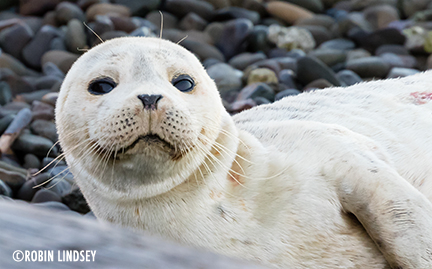
The curious pup, estimated 4-6 months old, watched as Lynn closed off the area, stretching yellow tape between orange cones and sandwich boards, around a picnic table and a prickly “sticker” bush, since the ground was too frozen to pound in stakes. Reluctantly removing her glove in the frigid 24 degree air, she speed dialed the Volunteer Scheduler for the day, Jonel, who began lining up Seal Sitters for what could potentially be another long day on the beach. On Wednesday, this same pup nicknamed Hope, did not return to the water until around 5pm, well after dark.
While John and Lynn kept Hope safe from disturbance, First Responder Robin began the process of lining up a health assessment by a NOAA-authorized consulting veterinarian, a recently implemented program to assist stranding networks with on-the-beach evaluations. Handling and transporting an animal for evaluation causes undue stress, which has its own negative impacts. Examinations are only done when there is sufficient cause or concern.
The day before, volunteers noticed the pup had a number of pale bloody spots on her white coat - perhaps Hope had a serious case flipper lice and had been scratching the areas raw. However, in closer review of photos on a computer that evening, things looked suspicious. There was a possibility these were punctures, though difficult to tell in the roughened fur. The only way to know for sure would be a closer examination and we were lucky that the pup had indeed returned for another day of rest.
After consulting with regional coordinator for NOAA’s Marine Mammal Stranding Network, Kristin Wilkinson, a call was placed to PAWS Wildlife Center to ensure the facility could accept the pup for treatment if necessary. The next call was placed to Dr. Lesanna Lahner, consulting vet and Executive Director of the newly-formed SR3, a non-profit dedicated to marine mammal health.
Early in the afternoon, the team of Seal Sitters responders and SR3’s Dr. Lahner and Casey Mclean discussed the next steps, while observing the sleeping pup. As the team approached, the now awake and feisty pup was captured with a net and examined on the beach. Blood oozed from what was definitely many puncture wounds. It was obvious Hope needed to get treatment. Seal Sitters volunteer Bob offered to make the long drive north and transport Hope to PAWS in Lynnwood. Upon arrival, rehabbers stabilized the pup and cleaned out her wounds.
We were stunned to learn that Hope, a female weighing about 34 lbs, had more than 20 puncture wounds on her small body, believed to be from an unidentified animal(s) - possibly canine, but unable to say with any certainty at this time. Thankfully, the bites were not deep and not yet abscessed.
Hope survived the night, but PAWS staff is cautious about her survival, as there are some bleeding issues not really explained by the superficial wounds. The reason for the bleeding continues to be investigated. She has been given a little pool to help keep her hydrated and active and the wounds moist. Hope is also receiving treatment for parasites, common for all weaned seal pups during winter months, which contributed to her occasional coughing spells on the beach and often leads to serious viral conditions.
Seal Sitters will keep you posted about Hope’s condition and any new information that comes to light regarding the cause of the puncture wounds. Thanks to all of the volunteers who protected the little pup during her stay on the beach and to supporting members of NOAA West Coast MMSN who assisted in her rescue. Heartfelt thanks to PAWS for their kind and expert care of wildlife. We hope for this pup’s recovery and release back to the waters of Puget Sound.
PUPDATE 1/19/17
PAWS Wildlife Rehabilitation Manager, Emily Meredith, reports that seal pup Hope is feisty and doing “pretty well.” She’s eating fish on her own in an outdoor pool and has begun treatment for lungworms. The treatment itself poses health risks for animals and rehabbers remain cautiously optimistic about her recovery.
Chubby rehabbed pup Paz returns home to Puget Sound
Mar/08/16 12:07 PM
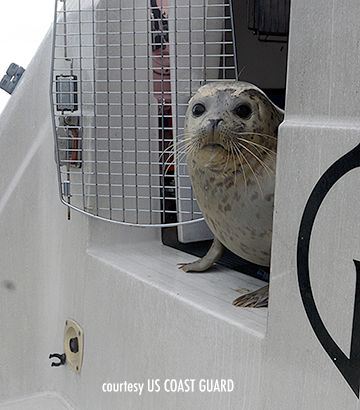
In December, the female pup was suffering from seizures on a cold and wet afternoon at Jack Block Park, notorious for illegally off-leash dogs. Seal Sitters first responders, authorized members of NOAA’s West Coast Marine Mammal Stranding Network, transported the hypoglycemic and largely unresponsive pup for evaluation at the Lynnwood facility, fearing she would require euthanasia. PAWS rehabbers were able to stabilize and hydrate her and Paz began a long recovery after a tenuous couple of weeks.
Severely emaciated and weighing only 12.8 kgs when rescued, the estimated 7-9 month-old pup was a true “blubberball” at her release on Monday, tilting the scale at 35 kgs (75 lbs). Pups are weaned around 4 weeks of age and are then entirely on their own, often struggling to survive wet fall and winter months. Click here to view a map of harbor seal pupping season in Washington.
It should be noted that only members of NOAA’s Marine Mammal Stranding Network - or their authorized agents - can legally handle and transport marine mammals. It is a violation of Federal Law to touch, feed, move or harass marine mammals. If you see a seal pup on the beach, please contact your local stranding network (network map here).
Thanks to PAWS dedicated staff for nursing the pup back to health. Huge thanks as well to the US Coast Guard Auxiliary boat crew that released Paz back where she belongs, the culmination of a true team effort (view a video of the release on USCG Facebook page).
Christmas seal Paz improves in rehab
Dec/29/15 03:11 PM
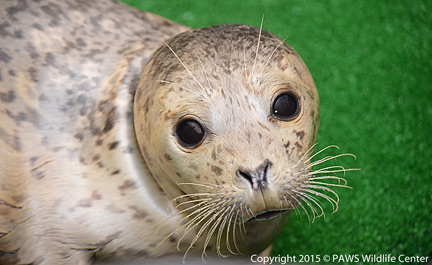
Paz, who was suffering from seizures, was rescued by Seal Sitters first responders from a West Seattle public beach early in the evening on the 22nd.
Examination at PAWS revealed that in addition to suffering from emaciation and hypoglycemia, Paz also had lung worms, but was not stable enough to be treated for the parasite load. Underweight seal pups with weakened immune systems often become infested with parasites during the cold, wet fall and winter months, which can result in serious respiratory issues and pneumonia. It is great news that Paz has the strength to start treatment to clear her lungs of dangerous parasites. She will continue to be closely monitored by PAWS’ rehab staff.
We are encouraged that Paz, a tiny pup measuring only 83cm in length, is on the mend enough to be enjoying swims in a big pool, complete with a green astroturf haulout (photo above). Her rehabilitation will be lengthy and Paz still faces many difficulties on an uphill road to recovery.
Seal pup Little Dipper returned to the wilds of Puget Sound
Oct/17/15 08:01 AM
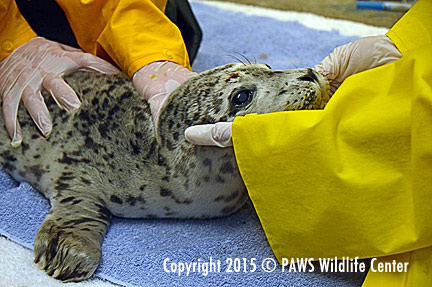
Little Dipper’s stint of rehabilitation at PAWS Wildlife Center (intake exam photo at left) was a bit longer than a typical two-month duration because he was slow to pack on weight. A newborn seal pup in rehab must be taught to eat whole fish since they are not able to learn from other seals in the wild. When finally released on October 9th, he weighed over 30 kgs (66+ lbs) - a true blubberball! The pup weighed only about 18 lbs when taken in for stabilization and treatment.
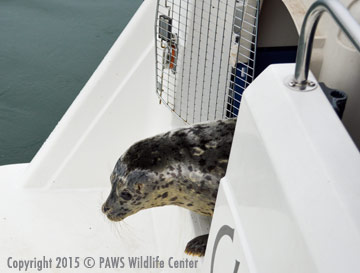
Little Dipper was released, along with another rehabilitated seal pup, near a harbor seal haulout. The photo at right shows Little Dipper emerging from his kennel on the boat transom, seconds before plunging into the water and swimming off. We so hope that these two young pups navigate the waters successfully and thrive together in the vast expanse of Puget Sound - and find safety when resting onshore.
Seal Sitters MMSN extends heartfelt thanks to the dedicated staff at PAWS for giving Little Dipper a second chance at life and generously providing photos to share with volunteers and the public.
If you see a seal pup (or any marine mammal) with a tag and are able to get the number thru binoculars or with a telephoto lens at a distance, please forward the location information and photos to Seal Sitters.
Seal pup Little Dipper fattens up in rehab
Sep/12/15 07:54 PM
Seal Sitters has received great news that seal pup Little Dipper, rescued from Lincoln Park at the end of June, is packing on the pounds at PAWS Wildlife Center in Lynnwood. Abandoned on the beach at the popular park, Little Dipper weighed a mere 8.4 kg (18.5 lbs) on intake at the rehabilitation facility. He now weighs a respectable 22.5 kg (49.6 lbs). The pup’s thick layer of blubber will help keep him warm and sustain him with energy once he is back foraging all on his own in the cold waters of Puget Sound.
If all continues well, the plan is to release Little Dipper at the end of this month. Prior to release, all pups are given a thorough examination to make sure there are no underlying health issues. We hope Little Dipper sails through his exam and back to the wild soon!
If all continues well, the plan is to release Little Dipper at the end of this month. Prior to release, all pups are given a thorough examination to make sure there are no underlying health issues. We hope Little Dipper sails through his exam and back to the wild soon!
Abandoned newborn seal pup rescued from Lincoln Park
Jun/28/15 12:49 PM
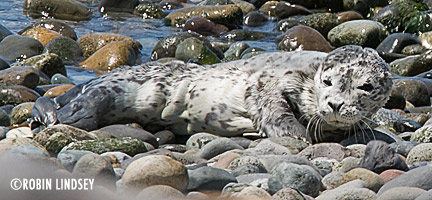
The pup was first sighted on the beach by Colman Pool early Thursday morning, but was not immediately reported to Seal Sitters. When we received a report hours later, First Responder Lynn arrived at the Park and saw four off-leash dogs on the beach. According to the woman who called the hotline, the pup was scared into the water by approaching people. The pup was swimming around in the water, desperately trying to crawl up onto a cement pillar just offshore. Thankfully, he returned to the beach shortly thereafter and Lynn established a large tape perimeter. She knew that any pup on the beach in South Puget Sound in late June/early July is a newborn and would still be nursing.
Under an unrelentingly hot sun, the very tiny pup was watched over by volunteers in shifts. Due to close proximity to the sidewalk and public pool, visitors to the park were asked to take a short detour around the pool building. This was all in hopes that mom might return to feed the thin pup. Except for a few peeved people, everyone was extremely cooperative, especially when they realized the urgent situation for the pup. However, with a park full of activity, including people along the water’s edge north and south of the perimeter, and the excited voices of children swimming in the nearby public pool, the scenario of mom’s return was extremely dubious. The pup entered the water several times during the day, probably taking a dip to cool down, sometimes calling plaintively to be fed. At 10pm when darkness fell, there was still no sign of mom swimming anywhere nearby.
On Friday morning, the pup was discovered onshore just south of the point where the pool is located. First Responders David and Eilene set a generous perimeter and volunteers were lined up for yet another terribly hot and busy day at the Park. The pup, nicknamed Little Dipper, was markedly thinner and much less alert than the previous day. Health assessment photos taken with a long telephoto definitively showed the the pup’s jutting hip and shoulder bones. It was now clear that the pup was emaciated and not being fed.
Not every struggling seal pup is a candidate for the very few spaces available at our Northwest rehabilitation facilities. Each pup is evaluated on a case by case basis for candidacy since the harbor seal population is considered to be at healthy levels and there is a 50% mortality in the wild for pups in their first year. It is NOAA’s policy that spaces are generally reserved for cases of human interaction, including pups with serious injuries. A seal pup that ends up in rehab will usually be at a facility for two or more months.Read here about NOAA’s rehabilitation policy for full-term pups.
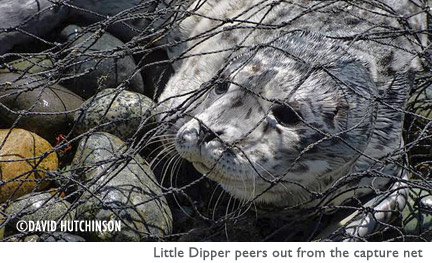
Since the pup was just feet from the incoming tide, a salmon landing net on the end of a pole was gently placed over the pup to prevent his escape. Much to our surprise (and not shown in photos), Little Dipper had a fleshy umbilical cord dangling from his sunken belly and estimated to be 3-5 days old.
Interestingly, on Wednesday evening Seal Sitters’ hotline received a report that a pup with umbilicus attached had followed a man in his watercraft off Emma Schmitz Park. We are assuming this was Little Dipper.
On arrival at PAWS, the male pup weighed a mere 8.4 kg and veterinarians confirmed the pup was emaciated and had not eaten in days. Little Dipper had two puncture/bite wounds about 1/2” deep on the head and a laceration near the tail. The wounds do not appear to be serious and are being treated with antibiotics.
On Saturday, PAWS staff reported that Little Dipper was much more vibrant after being hydrated and stabilized. The prognosis is now good for his survival, assuming there are no underlying health issues.
Thanks to all of the many volunteers - including a number of our brand-new volunteers from the June training - who helped out over the two days Little Dipper was on shore. Dealing with large crowds of people can be a challenge and everyone performed fantastically. Seal Sitters would also like to give special thanks to Seattle Parks’ staff Carol, Charles, Dino and Kyle who provided assistance on Friday. We so value our great relationship with the Southwest Division.
Stay posted for health updates on Little Dipper from the dedicated rehab folks at PAWS!
PUPDATE (7/3/15)
Little Dipper is doing pretty well according to PAWS Wildlife Center rehabilitation manager Emily Meredith. The pup’s wounds, including the two punctures on the head from an undetermined animal, are healing thanks to antibiotics. Little Dipper is being tube-fed “seal formula.” While formula is never as good as a mom’s milk with her natural antibodies, he has gained almost a full kilogram in weight under PAWS’ care. Little Dipper has been enjoying his big outdoor pool.
See recent photos and read about Little Dipper’s treatment at PAWS on their blog here. We can’t thank PAWS dedicated staff enough for giving this pup a second chance.
Steller sea lion pup goes back home to the wild
Apr/19/15 11:28 PM
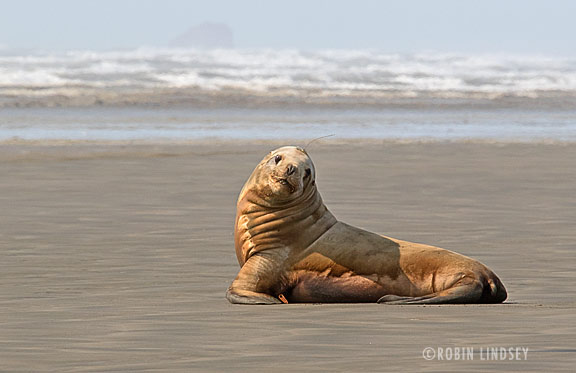
Late Thursday night, two Marine Mammal Stranding Network teams piled into pickups and hit the highway - one in California, headed north and the other in Washington, headed south - with the intent to rendezvous in southern Oregon at 6am Friday morning. Why? To transport and release a rehabilitated Steller sea lion pup, rescued many months before in the Pacific Northwest and rehabbed at The Marine Mammal Center in Sausalito.
Finally, at 2:30 Friday afternoon, the bleary-eyed Washington contingent (consisting of WDFW biologist Dyanna Lambourn, her intern and grad student Erin Dagnese and PAWS Wildlife Center naturalist Jen Mannas) drove onto the sand at a Moclips beach. In a large cage on the back of the truck, the animated pup soaked in the smell and sounds of the Pacific Ocean. Thanks to this tremendous joint effort, he was back home and soon to be free.
Last fall, the 4-month-old male pup stranded on the beach at Ocean Shores. On October 3, 2014, a group of people illegally dragged the helpless, weakened pup a long distance back to the water.
When Ocean Shores Police Department Officer Henderson arrived on the scene, he found the unresponsive pup rolling in the surf. Quickly, he rescued the pup from the waves so he wouldn’t drown. WDFW Marine Mammal Investigations responded and the animal was taken to WDFW’s facility where he was hydrated, stabilized and observed overnight. Weighing only 31kg (about 68 lbs), he was terribly emaciated for his age.
The following morning, the pup (nicknamed Henderson) was transported to PAWS Wildlife Center in Lynnwood for short-term rehabilitation. In mid-November, he was flown courtesy of the Coast Guard to The Marine Mammal Center (where he was nicknamed Leo because of a name conflict) to complete his lengthy rehab and recovery and enable critical socialization with other animals. It’s not uncommon for a Steller sea lion pup to nurse on mom’s milk for one - three years. Separated from his mom for unknown reasons, Leo Henderson needed to pack on weight and learn to survive on his own.
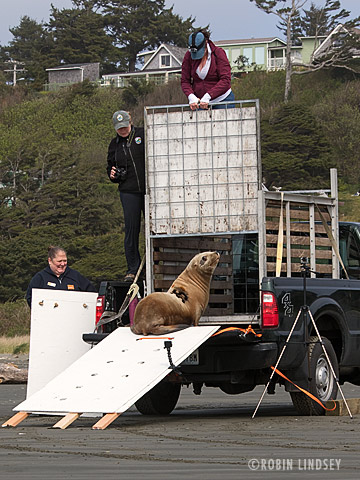
As everyone manned their positions, the cage gate was lifted open and the stout, golden pup emerged, sporting a satellite tag to track his travels and identification numbers “35” dyed onto his side. After surveying the situation, he leapt from the ramp. A couple of u-turns later, he eventually lumbered across the wide expanse of beach toward the ocean.
Resting briefly at the water’s edge, he turned to look back at those who had given him a second chance at life. Leo Henderson then bounded into the surf. His head popped up periodically as he navigated a series of crashing waves - and then he was gone. The dedicated team stared out into the vast Pacific. It had truly been a long road for Leo Henderson.
Because of the satellite tag temporarily glued to his fur (it will be shed along with the dyed id numbers during the molt of his coat), you can follow his movements along the Pacific Coast here. The data will help researchers learn more about Steller sea lions. The pup is a member of the Eastern stock of Steller sea lions which were recently delisted as threatened from the Endangered Species Act. The population is rebounding, but still recovering. Check back for updates on his travels.
Thanks to everyone involved - NOAA (special kudos to Kristin Wilkinson), WDFW, United States Coast Guard, PAWS Wildlife Center and The Marine Mammal Center - for your extraordinary efforts to save this special pup.
Rehabbed Canadian seal pup visits South Puget Sound
Nov/13/14 03:18 PM
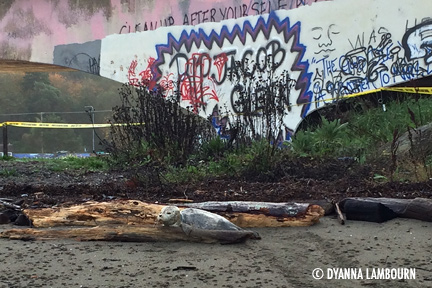
Dyanna noticed the pup had a 4-digit tag on the left rear flipper, indicating a stint at a rehab facility. In Washington State, rehabilitated pinnipeds have a 5-digit tag. She taped off the area with yellow Protected Marine Mammal tape, posted informational signs and observed behavior at length before leaving the somewhat secluded location, popular with a “party” crowd. Early the next morning, the pup was back on the beach.

Three months later, far away in Washington, WDFW monitored Lithium’s activities in South Puget Sound for 5 straight days. Lithium, wary of human presence, was observed coming and going from the beach at different times - a good sign. The spit is the only place to haul out and rest in that area when there are extreme high tides, such as last weekend. It is located in Burley Lagoon, a shallow estuary with lots of small bait fish, cutthroat trout and chum salmon returning this time of year. Thankfully, there has not been much boat traffic or gillnet fishing of late. Other seals have been observed routinely resting on the oyster floats inside the lagoon in the early morning or late afternoon. The pup is in fair body condition, common to many struggling weaned pups during late fall and winter months. We hope our visitor from north of the border packs on some much-needed pounds. Lithium was last sighted on Sunday afternoon.
A recent study by SeaDoc Society of satellite-tagged harbor seal pups revealed that rehabbed pups travel much farther in search of food than wild-weaned pups - in fact, three times as far and wide. This would only contribute even more to Lithium’s low body weight as she expends more calories traveling greater distances. Seals usually stay within a 5-mile radius their entire lives. If you happen to see a tagged animal, please inform your local marine mammal stranding network of the location (map with networks contact info here). This information is extremely valuable in helping biologists determine success rates of rehabbed seals.
Rescued and rehabbed pup Junebug goes home to the wild
Sep/18/14 06:10 PM
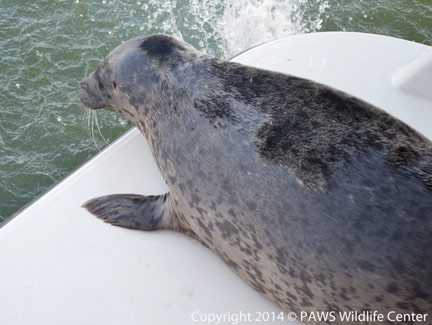
The abandoned and estimated only 5-8 day old pup was rescued by Seal Sitters MMSN from West Seattle’s Duwamish Head on July 1st. He weighed only 8.6 kg upon intake at the Lynnwood urgent care facility. Junebug was a whopping 31.1 kg on release day (see photo courtesy of PAWS). The tubby pup was released at a known harbor seal haulout near Everett with the help of the Coast Guard.
Rehab for newborn seal pups - and weaned pups - is a lengthy process, as indicated by Junebug’s two-month stay at PAWS. There is no evidence that a fattened up rehab pup has greater odds of survival than wild-weaned ones. All pups face 50% mortality their first year and some would argue that a week-old rehabbed pup who has not been taught to forage in the wild faces even worse odds.
In late January of 2013, Seal Sitters’ first responder noticed a red tag on a pup resting near Salty’s on Harbor Avenue (rehab tags changed from red to orange in 2014). A check in the stranding network database revealed that the pup, whom volunteers nicknamed Ruby, had been rehabbed at PAWS and released in October of 2012 at a harbor seal haulout south of Tacoma. Ruby had made the long trek to Seattle and Seal Sitters volunteers watched over her almost every day - keeping her safe from disturbance - for the next few months at West Seattle’s Jack Block Park. She befriended another weaner pup nicknamed Buddy at the park, but they finally travelled on at the end of April.
The Marine Mammal Stranding Network would like to receive reports which include i.d. numbers of tagged seals, dead or alive. With respect to harbor seal pups, these reports are extremely helpful in determining the survival rate of rehabilitated animals.
Thanks so much to PAWS Wildlife Center and their awesome staff for giving Junebug a second chance at life!
Pup responding well in rehab
Jul/03/14 05:24 PM
(SEE LATEST PUPDATE END OF STORY)
Junebug, the dehydrated and thin newborn harbor seal pup taken to rehab on Tuesday afternoon, is doing well at PAWS Wildlife Center. Emily Meredith, Wildlife Rehabilitation Manager, reported yesterday morning that Junebug was “nice and bitey” after his first night of care - this feistiness is a good sign. On intake, the pup was given fluids for hydration and antibiotics for a swollen puncture wound on one of his front flippers. His chin was also scuffed up from sharp barnacle-covered rocks.
We just received word this afternoon that Junebug is responding well to his treatment and his wounds are healing. However, he still has a long road ahead of him. He needs to gain weight and pack on a thick layer of blubber to provide energy and warmth in the wild. He also needs to learn to eat solid food and how to hunt live prey. Learning to catch fish in a small rehab pool is vastly different than foraging for fish in the wide expanse of Puget Sound.
If Junebug manages to survive the lengthy rehab stay (his health is still tenuous), he will be released near a harbor seal haul-out, where hundreds of seals of all ages gather to rest and forage. There is no guarantee about his success post-release since his mom was not around to teach him all about how to be a harbor seal. It is the hope that Junebug will assimilate into a seal colony where there is safety in numbers and he can learn foraging and social skills from other seals.
PUPDATE (July 7, 2014)
We’re elated to report that Junebug continues to fare well in rehab. He has gained a bit of weight and is spending his days lounging on his pool pad, “swimming at his leisure”.
Junebug, the dehydrated and thin newborn harbor seal pup taken to rehab on Tuesday afternoon, is doing well at PAWS Wildlife Center. Emily Meredith, Wildlife Rehabilitation Manager, reported yesterday morning that Junebug was “nice and bitey” after his first night of care - this feistiness is a good sign. On intake, the pup was given fluids for hydration and antibiotics for a swollen puncture wound on one of his front flippers. His chin was also scuffed up from sharp barnacle-covered rocks.
We just received word this afternoon that Junebug is responding well to his treatment and his wounds are healing. However, he still has a long road ahead of him. He needs to gain weight and pack on a thick layer of blubber to provide energy and warmth in the wild. He also needs to learn to eat solid food and how to hunt live prey. Learning to catch fish in a small rehab pool is vastly different than foraging for fish in the wide expanse of Puget Sound.
If Junebug manages to survive the lengthy rehab stay (his health is still tenuous), he will be released near a harbor seal haul-out, where hundreds of seals of all ages gather to rest and forage. There is no guarantee about his success post-release since his mom was not around to teach him all about how to be a harbor seal. It is the hope that Junebug will assimilate into a seal colony where there is safety in numbers and he can learn foraging and social skills from other seals.
PUPDATE (July 7, 2014)
We’re elated to report that Junebug continues to fare well in rehab. He has gained a bit of weight and is spending his days lounging on his pool pad, “swimming at his leisure”.
Seal pup taken to rehab after rescue from rocks
Jul/01/14 08:35 PM
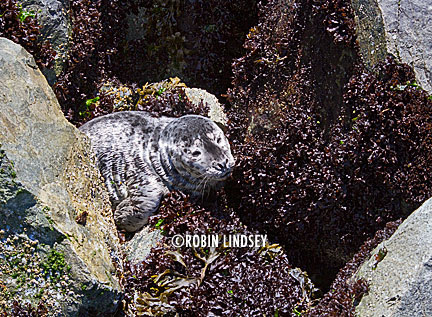
With the area finally secured, volunteers had a chance to observe the pup’s behavior and body condition. He was identified as Junebug by comparing facial markings of photos taken yesterday afternoon when the pup had rested along the Alki seawall. He was forced into the Sound by the surging tide around 6pm.
It appears that the pup swam to this location last evening, but was not visible to volunteers searching the beach. This morning, it became obvious that the pup was wedged in the jagged rocks - above the tideline, but not for long as the tide would be coming back in at a much higher level. Junebug tried, but could not free himself as much as he struggled. We knew we needed to pluck the pup from the rocks - to save him from exposure in the expected 90 degree heat and potential drowning at high tide.
Junebug’s body weight also looked noticeably thinner than that of a nursing pup with attending mom. After consultation with NOAA’s stranding expert and WDFW’s marine mammal biologist, it was determined that the dehydrated pup was likely abandoned at this very urban location. He was taken to PAWS Wildlife Center for assessment and admitted into rehab. Junebug is a full-term male pup who is between 5-8 days old and it is estimated that he had not been fed for at least 3 days.
Rehabilitation of harbor seal pups is a very lengthy and costly endeavor. Since Junebug is so young, he could be at PAWS for months. If you’d like to help PAWS defray costs for giving this pup and others a second chance to survive in the wild, please make a donation here.
Huge thanks to our colleagues at NOAA, WDFW and PAWS. We will keep you posted with updates on Junebug’s progress.
PUPDATE (7/3/14)
Junebug is faring pretty well so far in rehab. Please see July 3rd post for details.
Heartbreak as premature seal pup born along Alki Beach
Jun/11/14 06:51 AM
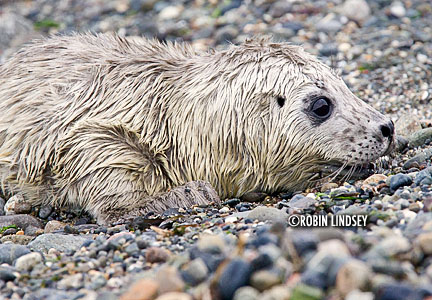
Within minutes, Seal Sitters first responder David and volunteer Eilene were on the scene attempting to establish a protective perimeter with tape and cones, asking people to please stand back. A man with a leashed dog illegally on the beach not only refused to leave the sand, but insisted that it was his right “as a taxpayer” to continue his path past the pup. Apparently, this taxpayer felt it was also his right to break municipal law by having his dog on a Seattle public beach - where dogs are not allowed leashed or unleashed. He finally left after an intense verbal exchange. Another dog owner was nearby throwing a ball into the Sound for his off-leash dog to fetch. We cannot stress enough that dogs are unpredictable and a documented danger to seal pups, causing injury and death to pups in Washington State each year. This was not a good start to our first response of the 2014 seal pupping season.
It was obvious that the surf-soaked pup was a newborn because of the bright flesh-colored umbilicus cord dangling from the pup’s belly. Her body was covered with a long, wavy white lanugo coat (photo above), an indication she was born a month prematurely. A full-term pup will shed this fluffy coat in the womb. We knew this was going to be a difficult situation for both the pup and Seal Sitters, who must try to keep this busy beach area quiet enough that mom might feel safe enough to return for her newborn, who could not survive without her.
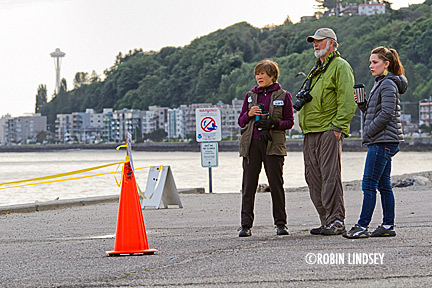
Seal Sitters volunteers tried to keep a low profile at the far ends of the yellow tape boundary, explaining to sympathetic and cooperative onlookers that this pup was believed to have been born that very day. Huge thanks to WDFW marine mammal biologist Dyanna Lambourn for her review of our photos and consultation as to pup’s age and condition.
The pup, nicknamed Luigi, was observed by volunteers throughout the day and discreetly during the dark of night and wee hours of the morning. It was crucial to know if an attending mom would return - no mom ever appeared to our knowledge. During the early morning hours the thin pup moved a bit further up the beach and at first light, the perimeter was adjusted to protect her in what was anticipated to be a warm, and therefore, very crowded day at Alki. Shown in the photo at sunrise with Seattle’s iconic Space Needle in the background are first responder Lynn, science and education advisor Buzz and new volunteer Savanna.
By early afternoon, it became increasingly likely that for unknown reasons, the pup was abandoned with no attending female who would care for this tiny pup. We have no idea what the circumstances surrounding the birth were. Was Luigi born on Alki and mom was scared back into the water by people or dogs before bonding with her pup? Did she give birth just offshore because the beach was busy, but the pup made it to shore alone? Did she die during the birth? If anyone witnessed an adult onshore or very close to shore, perhaps in distress, along Alki Beach Monday afternoon, please contact us. We do know that this pup was too tiny and weak to have swum any substantial distance after birth.
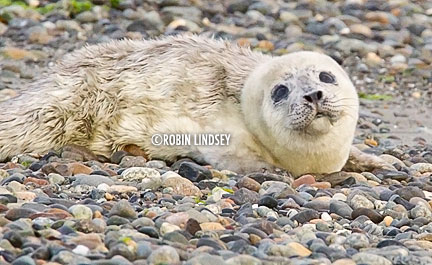
Premature pups - especially one born a month early - rarely survive the lengthy rehab process. If they manage to stabilize for the short term, too often it is only to die shortly after. Nature can be harsh. About 90% of lanugo pups born in the wild don’t survive - and most of those are partial lanugos, not a full month premature. Lanugos require much more maternal care than a full-term pup and some less experienced moms will make the decision to abandon a premature pup whose lungs and muscles may not be fully developed, plus any other factors that may have contributed to an early birth. Even full-term, healthy wild-weaned pups have just a 50% chance of surviving their first year. If a full lanugo pup did manage to make it through rehabilitation and was released, those already daunting odds become even greater against survival in the wild - never having been taught by mom to forage in the expansive waters of Puget Sound. A premature pup’s (for that matter, all pups) best chance is always with mom.
While waiting for authority to transport Luigi for health assessment and as the sun heated up, the pup worked her way down to the water’s edge to thermoregulate and cool down her body temperature. As a crowd of adults and children cried out anxiously, Luigi was swept up in the surf, rolling over and over without the strength to keep from drowning. SS lead investigator Robin donned protective exam gloves (like most animals, seals can transmit disease) and rescued the pup, too weak to swim, from the swirling waves.
Luigi was moved higher up on the sandy beach and we placed an urgent call requesting approval for assessment. That wish was granted and the pup was placed in a kennel and driven to PAWS Wildlife Center in Lynnwood, the only rehab facility in South Puget Sound. Only members of NOAA’s Marine Mammal Stranding Network are authorized to handle and transport marine mammals. It is illegal for the public to touch, feed, move or harass marine mammals.
Sadly, on intake at PAWS, it was determined that sweet Luigi, a female weighing only 5.5 kg (12 lbs, 2 oz) and measuring 70 cm (27.6 in), needed to be humanely euthanized. She was the youngest pup PAWS was known to have received. We thank PAWS for their kindness. We thank, too, our many volunteers who gave Luigi the best chance possible to survive and enabled her to rest quietly on West Seattle’s shore. Luigi gave us all great joy - and educated many people about this special species that is so dear to Seal Sitters MMSN’s heart. On this sad note, we also extend our thanks to the caring public who showed such warmth to our volunteers and to this little seal pup.
It takes a village to protect urban seal pups
Feb/26/14 06:02 AM
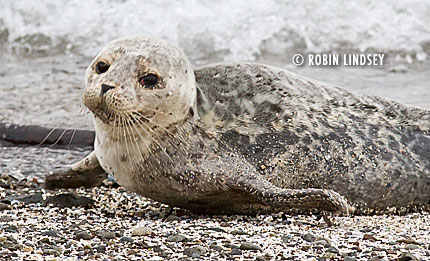
Early Saturday morning, Seal Sitters MMSN volunteers David and Eilene drove through the Don Armeni public boat launch on their way home from downtown Seattle. First responders, on and off duty, routinely look for pups in dangerous locations, such as the ramp, where pups often come ashore to rest. Sure enough, a pup was sleeping on the sand-covered cement, vulnerable not only to curious people, but much more worrisome, offleash dogs and boat traffic.
David quickly grabbed barricades and tape stashed at the location and established a perimeter to protect the pup in one of three lanes available for vessel launch and retrieval. Thankfully, in this boating off-season and cold rain, no boats were present.
Other first responders were on the scene in minutes to lend a hand. Scheduler for the day, Lynn J, was notified and she quickly referred to our online calendar and began calling volunteers. An iPhone was used to send out an APB “seal on the beach now” to all volunteers.
In 2-hour shifts, volunteers watched over the pup throughout the day in a cold, often drenching, rain. Nicknamed Penny (shown here moving closer to the sea wall, away from breaking waves), the thin pup showed no overt signs of illness, but lack of interest in people and nearby barking dogs was definitely a concern. A pup estimated to be anywhere from 6-8 months old should be much more wary of disturbance. However, there were no coughing spells or discharge from the nose or mouth - signs of parasite and viral load. Due to the physical constraints of the location with a parking lot and need to keep boat access open on the remaining ramps, the public was allowed closer than the ideal. The few boat owners that launched during the day were extremely cooperative and happy to give a resting pup some space.
Volunteers spoke with passersby who struggled to discern the shape of the pup on land even though they were just yards away. From the back, Penny looked like a dark rock. From the front, covered in sand and crushed shells, she blended into the shore. The spotted coat provides seals excellent camouflage from predators - or an inquisitive public. Dogs, however, with their keen sense of smell are easily able to seek out a pup - all the more reason to keep dogs leashed near beaches and well away from vulnerable young seals.
After dark, in the bitter cold 37 degree weather, volunteers continued to check on the pup during the night. Plans were put into place to capture the pup in the early morning hours for transport to rehab if the pup was still on shore. It is not unusual for a pup to spend well over 12 hours on shore, but something definitely seemed amiss for this increasingly listless pup. NOAA requests that no intervention occur until a pup has been onshore a minimum of 24 hours unless circumstances are unique - such as human interference - since there is a 50% mortality in the wild and there are extremely limited resources for rehabilitation in the Puget Sound region.
At high tide, around 1:30 am, Penny was no longer at the ramp. Volunteer Buzz located the pup at 2am, sleeping on the sand at nearby Duwamish Head, and put up a tape perimeter to prevent people from walking down the stairs to the beach. At 5:30 am, it was clear the pup was in distress and a first responder team assembled at 7am’s first light to capture the pup only a few feet from the approaching tide. The largely unresponsive pup was taken to PAWS Wildlife Center for stabilization and treatment, but died upon arrival.
If a necropsy is performed, we will share the results. Thanks to our many amazing volunteers who helped give Penny some peace on the beach. And thanks as always to PAWS’ caring staff. This is a very sad day for all of us.
NECROPSY RESULTS 2/26
PAWS Wildlife Center’s veterinarian performed a necropsy on Penny yesterday. The exam showed that the pup had pneumonia related to lungworm with what appears to be a sudden onset. The lack of obvious symptoms is somewhat baffling. The male pup weighed 14.7 kg. We are extremely grateful to PAWS.
Moonshadow loses battle to survive
Dec/05/13 04:19 AM
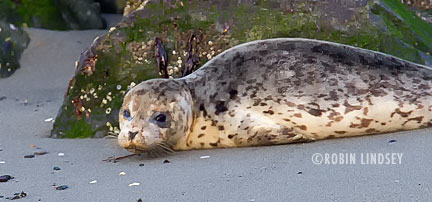
Seal Sitters’ first responders and volunteers had observed Moonshadow over the course of a week as he came ashore almost every evening at dark and returned to the Sound near sunrise. On Sunday, he spent an uncharacteristic 22 hours on the beach which raised concern. The next day, however, Moonshadow returned to his behavior of 12-14 or so hours on shore. Still, it was evident that the pup was having some health issues, though he was not exhibiting severe symptoms such as prolonged coughing. On Wednesday morning the pup remained on the beach at daylight, but was at the tide line and capture was too risky. Responders had to be assured that we could successfully capture Moonshadow - if we were not successful, the frightened pup would most likely abandon this relatively safe haul-out site (a small beach with only one public entrance, blocked off with Protected Marine Mammal tape to deter access). Because of PAWS shortened winter hours, a capture could not be performed after dark. Early Thanksgiving morning, the sleeping pup had blood from the nose and the conditions were ripe for capture. First responders swiftly swept up the pup and transported him to PAWS.
Moonshadow weighed 11.7 kg on intake Thanksgiving morning - certainly thin, but not as thin as most of the pups we have protected this year. He did exhibit discharge from the nose and mouth. The pup died overnight.
NECROPSY FINDINGS
Heartfelt thanks to PAWS’ staff and Dr. Bethany Groves for performing the necropsy in hopes to determine cause of death. The necropsy revealed that his airways were “jam-packed” with adult lungworms and the pup had parasite-related nodules throughout his lungs. Additionally, Moonshadow had pneumonia, likely due to the parasitic infestation. This infection is likely the cause of death. The pup also had a large number of roundworms in his stomach, but no food. Medical treatment to kill off such a high worm load can be extremely dangerous in itself to a weak pup. All weaned pups have some level of parasite load this time of year, but those with weakened immune systems are often not strong enough to keep opportunistic parasites and related viruses at bay - a very sad and hard fact.
Thanks to Seal Sitters’ many dedicated volunteers and a concerned public who allowed Moonshadow to rest undisturbed on this urban beach. Moonshadow’s death reinforces just how vulnerable these seal pups are and how quickly their health can tailspin. Sharing the shore gives them a much better chance to survive.
Seal pup rescued by Seal Sitters returns home to Puget Sound
Nov/25/13 10:51 AM
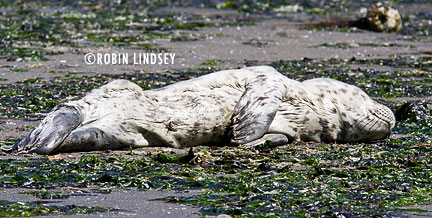
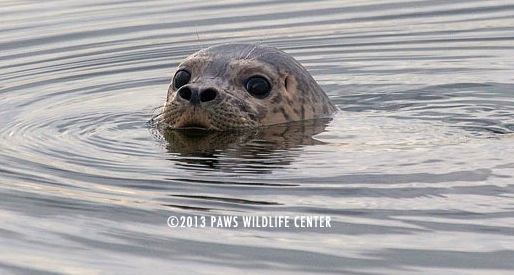
We are thrilled to report that Snapper weighed a whopping 73 lbs when released - a true blubberball. This fat layer will help sustain the pup as he learns to forage in the huge expanse of Puget Sound. Huge flipper hugs to PAWS’ dedicated and amazing staff and the Coast Guard!
Snapper taken to rehab as options dwindle for struggling pups
Aug/07/13 10:05 AM
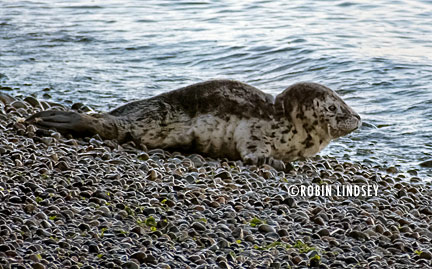
Yes, this is a Seattle public beach (and, therefore, dogs are NOT allowed), but it is also a beach that wildlife has a right to use, too. This exhausted, emaciated pup desperately needed a place to rest and it is hardly unreasonable to ask someone to go a few yards out of their way to help a wild animal survive. Not to mention, the Marine Mammal Protection Act protects these animals by law. Having already rescued a newborn pup early that morning because of human harassment resulting in abandonment, our responder was in no mood to have this struggling pup harassed as well.
Volunteers watched over the pup until dark, who spent the night on the beach and returned to the Sound about 8am Tuesday (see photo). Later in the day, we received a call from NOAA that a listless pup was at Cormorant Cove. The male pup, nicknamed Snapper and weighing just 8.8 kgs, was taken from the beach to PAWS Wildfife Center and is confirmed by spot identification to be the same Lincoln Park pup.
It is unfortunate to have to report that all of the spaces for rehabilitation are now full - almost all of the seal pups at PAWS had to be taken there because of human interference. This means that there are no options for helping seal pups for possibly up to two months - seal pup rehab is challenging, lengthy and expensive. NOAA wants these few spots reserved for animals that have been victims of human interaction - whether fishing gear injuries, illegal removal from a beach, causing abandonment by a seal mom, etc. If there were fewer cases of human interference, we would have more options to help other emaciated seal pups like Snapper.
STAY AWAY FROM RESTING SEAL PUPS! Yesterday, an abandoned pup had to be relocated from a small island to a nearby harbor seal rookery in hopes another nursing mom will adopt him. When the biologist arrived on Cutts Island, there was a family sun-bathing within feet of the tiny, skinny pup. Is it any wonder mom did not return when this island’s small seal colony is continually harassed by boaters who party within feet of them?
PUPDATE:
8/7/13
Sparkle, the newborn pup abandoned near Alki Beach due to harassment, is stabilized at PAWS and was outside in a pool yesterday morning. Snapper had an infected wound on his flipper (being treated by antibiotics), but thus far his most daunting battle is recovering from being so underweight.
9/9/13
We are so sad to report that Sparkle was euthanized at PAWS on September 9th. Veterinarian Dr. John Huckabee believes Sparkle’s immune system was not functioning properly, as she struggled the entire time she was there with digestive issues, ear and other infections and a heart murmur.
Seal pups in a daily struggle to survive - please give them space
Jul/26/13 08:20 AM
UPDATE 7/26 3:45pm
The Olympia pup, positively identified, is not in danger, but instead is a healthy-looking weaned pup exhibiting normal behavior. The report of a “starving...abandoned” pup caused a media flurry and demands of rescue from the public, but the pup in question was observed today sneaking a bit of milk from a female nursing her own offspring. Often, a pup will call out with a plaintive “maaaaaaaa” even after weaning, seeking an easier meal from a female’s nipple than searching for tiny fish in the waters of Puget Sound. This pup should and will stay in the wild - like all pups whenever possible. (note: Adding to confusion, video footage widely shown by one Seattle tv station is of a nursing age pup - not the one originally reported to authorities and photographed by The Olympian)
In the first year of life, a harbor seal pup is in a constant struggle to survive. With a 50% mortality rate in the wild, they must overcome many challenges: disease, infection, predation by shoreline predators or domestic dogs, conditions caused by premature birth, dehydration and starvation. This is, unfortunately, a fact of life - and death.
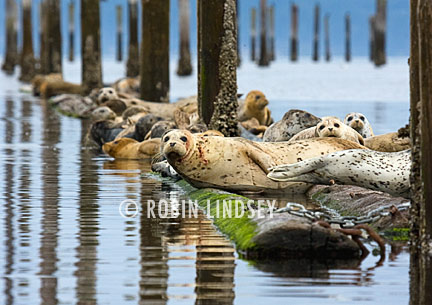 The current media coverage and resultant firestorm to rescue a “starving” seal pup in the Olympia area has overlooked some very important points. First of all, the pup is in a protected harbor seal haul-out and rookery. Each year, seals use a log boom in this bay to give birth and nurse their young (photo at left). Yesterday’s seal count at this thriving rookery, including logs just to the south, was 245 seals, of which 75 were pups. And each year at this rookery, between 5 and 20 pups die during pupping season, late June through September. In a nearby rookery, 30-60 pups die. The mortality rate at this rookery may be lower because it is indeed situated on the log boom, and much easier for seals to escape disturbance from eagles and coyotes (and boaters) because they are able to slip off into the water for protection. A number of pups may die and disappear into the water so are unaccounted for. This is the harsh reality of life for wild animals. Not every one survives nor should every one be rescued.
The current media coverage and resultant firestorm to rescue a “starving” seal pup in the Olympia area has overlooked some very important points. First of all, the pup is in a protected harbor seal haul-out and rookery. Each year, seals use a log boom in this bay to give birth and nurse their young (photo at left). Yesterday’s seal count at this thriving rookery, including logs just to the south, was 245 seals, of which 75 were pups. And each year at this rookery, between 5 and 20 pups die during pupping season, late June through September. In a nearby rookery, 30-60 pups die. The mortality rate at this rookery may be lower because it is indeed situated on the log boom, and much easier for seals to escape disturbance from eagles and coyotes (and boaters) because they are able to slip off into the water for protection. A number of pups may die and disappear into the water so are unaccounted for. This is the harsh reality of life for wild animals. Not every one survives nor should every one be rescued.
There has been a public outcry that the “abandoned” pup must be taken for rehabilitation. However, this pup is known to have come and gone from the logs into the water multiple times. There are many, many seals nearby. It has been documented in this and other rookeries that females will sometimes adopt an abandoned pup, nursing two at once (they only give birth to one pup). The body weight of this pup suggests that he or she might be sneaking milk from another mom - a female will sometimes relent to a persistent “sneaker”. And the possibility is not entirely ruled out that the pup is being nursed at night.
Rehabilitation is not the answer for all seal pups. First of all, many of them will not survive the stress of being captured and transported by car or truck to an authorized facility hours away. We must weigh many issues before making a decision to remove a pup from the wild. Even if they are rehabilitated and released months later with a dense layer of blubber, that does not ensure they will thrive in the wild. They still have only a 50% chance of survival their first year. A pup that has not been taught to hunt by mom has much less chance to forage successfully. A study by Sea Doc Society revealed that rehabbed pups travel much farther in search of food than wild-weaned pups, wasting precious calories. A human tossing fish into a small pool does not replicate catching fast-swimming fish in expansive waters. Rehabilitation does not guarantee an animal’s survival post release. Additionally, Washington has no major marine mammal rehab facilities. There is extremely limited space for lengthy pup rehabilitation, so each decision to remove an animal from the wild is on a case by case basis taking into account numerous factors. Read NOAA’s policy on harbor seal pup rehabilitation here.
The question has been asked, “What is the harm in helping him?” In reality, there is much harm that can be done. We cannot jeopardize the health of the many pups at this or any rookery in hopes of saving one. This time of year in Puget Sound, pups are being born every single day. If humans intervene and disrupt the normal activity in these areas, other pups may well be abandoned and starve to death. Human disturbance has serious consequences.
Seal Sitters supports the decision not to intervene in this case - and there is the fervent hope that this pup will make it. Sadly, we can’t save all seal pups. And many would argue, it is not our place in nature to do so. It is heartbreaking for any member of the Marine Mammal Stranding Network to have to observe a struggling pup and respect nature’s role. We are passionate about keeping seal populations healthy and thriving - and do everything we can to give pups the space to get stress-free rest, away from human interference. Not every seal pup will survive this pupping season and we all share sadness in that hard fact - but know that there is a reason for this very fragile balance of nature.
Do not take matters into your own hands if you come across a pup - they are protected by Federal law. It is illegal to feed, touch or move a pup. If you break the law and take a pup to a wildlife facility, they cannot legally treat the animal. NOAA’s Office for Law Enforcement will investigate all instances of human interference. Call NOAA’s stranding hotline at 800-853-1964 to report a pup you are concerned about.
Please read NOAA’s most recent Q&A publication “Share the Shore with Harbor Seal Pups” here. The document describes the life processes of harbor seals, what to do if you come across a pup and NOAA’s policy on rehabilitation. Please do “Share the Shore” and observe these magnificent animals quietly from a distance.
Please note: The Olympian newspaper which originally broke the story of a “starving” pup has now updated their website with the news that the pup is indeed a healthy, weaner.
The Olympia pup, positively identified, is not in danger, but instead is a healthy-looking weaned pup exhibiting normal behavior. The report of a “starving...abandoned” pup caused a media flurry and demands of rescue from the public, but the pup in question was observed today sneaking a bit of milk from a female nursing her own offspring. Often, a pup will call out with a plaintive “maaaaaaaa” even after weaning, seeking an easier meal from a female’s nipple than searching for tiny fish in the waters of Puget Sound. This pup should and will stay in the wild - like all pups whenever possible. (note: Adding to confusion, video footage widely shown by one Seattle tv station is of a nursing age pup - not the one originally reported to authorities and photographed by The Olympian)
In the first year of life, a harbor seal pup is in a constant struggle to survive. With a 50% mortality rate in the wild, they must overcome many challenges: disease, infection, predation by shoreline predators or domestic dogs, conditions caused by premature birth, dehydration and starvation. This is, unfortunately, a fact of life - and death.

There has been a public outcry that the “abandoned” pup must be taken for rehabilitation. However, this pup is known to have come and gone from the logs into the water multiple times. There are many, many seals nearby. It has been documented in this and other rookeries that females will sometimes adopt an abandoned pup, nursing two at once (they only give birth to one pup). The body weight of this pup suggests that he or she might be sneaking milk from another mom - a female will sometimes relent to a persistent “sneaker”. And the possibility is not entirely ruled out that the pup is being nursed at night.
Rehabilitation is not the answer for all seal pups. First of all, many of them will not survive the stress of being captured and transported by car or truck to an authorized facility hours away. We must weigh many issues before making a decision to remove a pup from the wild. Even if they are rehabilitated and released months later with a dense layer of blubber, that does not ensure they will thrive in the wild. They still have only a 50% chance of survival their first year. A pup that has not been taught to hunt by mom has much less chance to forage successfully. A study by Sea Doc Society revealed that rehabbed pups travel much farther in search of food than wild-weaned pups, wasting precious calories. A human tossing fish into a small pool does not replicate catching fast-swimming fish in expansive waters. Rehabilitation does not guarantee an animal’s survival post release. Additionally, Washington has no major marine mammal rehab facilities. There is extremely limited space for lengthy pup rehabilitation, so each decision to remove an animal from the wild is on a case by case basis taking into account numerous factors. Read NOAA’s policy on harbor seal pup rehabilitation here.
The question has been asked, “What is the harm in helping him?” In reality, there is much harm that can be done. We cannot jeopardize the health of the many pups at this or any rookery in hopes of saving one. This time of year in Puget Sound, pups are being born every single day. If humans intervene and disrupt the normal activity in these areas, other pups may well be abandoned and starve to death. Human disturbance has serious consequences.
Seal Sitters supports the decision not to intervene in this case - and there is the fervent hope that this pup will make it. Sadly, we can’t save all seal pups. And many would argue, it is not our place in nature to do so. It is heartbreaking for any member of the Marine Mammal Stranding Network to have to observe a struggling pup and respect nature’s role. We are passionate about keeping seal populations healthy and thriving - and do everything we can to give pups the space to get stress-free rest, away from human interference. Not every seal pup will survive this pupping season and we all share sadness in that hard fact - but know that there is a reason for this very fragile balance of nature.
Do not take matters into your own hands if you come across a pup - they are protected by Federal law. It is illegal to feed, touch or move a pup. If you break the law and take a pup to a wildlife facility, they cannot legally treat the animal. NOAA’s Office for Law Enforcement will investigate all instances of human interference. Call NOAA’s stranding hotline at 800-853-1964 to report a pup you are concerned about.
Please read NOAA’s most recent Q&A publication “Share the Shore with Harbor Seal Pups” here. The document describes the life processes of harbor seals, what to do if you come across a pup and NOAA’s policy on rehabilitation. Please do “Share the Shore” and observe these magnificent animals quietly from a distance.
Please note: The Olympian newspaper which originally broke the story of a “starving” pup has now updated their website with the news that the pup is indeed a healthy, weaner.
New study reveals seal pups learn foraging skills at early age
Dec/19/12 10:17 AM
SeaDoc Society has just released the findings of a study of 20 satellite tagged weaned harbor seal pups, half of whom were tagged in the wild and half after rehabilitation. The study shows that rehabbed pups travel greater distances than wild pups foraging for food. Read this fascinating story here.
West Seattle stranded seal pup Sandy was satellite tagged and released in late January this year after a lengthy rehab at PAWS. Hundreds of people logged onto SeaDoc’s site and followed her progress and travels around Puget Sound until she was found dead in April, entangled in derelict fishing gear. Her death put a face on the dangers of marine debris and pollution and a beach cleanup was held in her honor. Read about Sandy here.
West Seattle stranded seal pup Sandy was satellite tagged and released in late January this year after a lengthy rehab at PAWS. Hundreds of people logged onto SeaDoc’s site and followed her progress and travels around Puget Sound until she was found dead in April, entangled in derelict fishing gear. Her death put a face on the dangers of marine debris and pollution and a beach cleanup was held in her honor. Read about Sandy here.
Rescue of injured seal pup a combined effort of networks
Oct/16/12 08:54 AM
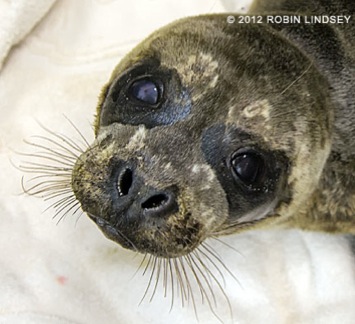
Yesterday, Seal Sitters’ volunteers met up with a volunteer from Vashon to transport an injured seal pup to PAWS in Lynnwood. Four NW marine mammal stranding networks had been on the lookout for the severely lacerated pup.
On Wednesday evening, our hotline received a report of a pup with a severe cut on a public beach in Des Moines near the marina. The reporting party, Pam, then had to leave the site briefly. Soon after, a team from WDFW Marine Mammal Investigations (Dyanna Lambourn and Josh Oliver) and MaST Stranding Network’s volunteer Mikiko, arrived on the scene, but the pup had vanished. This was quite a baffling mystery since the pup would have had to traverse a 60+ yard distance at low tide to get back to the water in a very short time. The team searched the vast beach in the darkness, but could see no sign of the pup. It is surmised that perhaps someone moved the pup back to the water.
At 6:30 am the next morning, Seal Sitters’ first responder scoured the shoreline as well as the docks at the marina, but again there was no sign of the pup. Late that afternoon, NOAA’s hotline received a call from Wolftown on Vashon (the marine mammal stranding network for the island) that an injured pup was seen on KVI beach. Photos were compared with one from Wednesday night and it was confirmed to be the same pup. It was encouraging that the pup was able to swim across Puget Sound with such an injury, possibly human-caused. Plans were set into motion to try to capture the pup for transport to rehab, but each time Wolftown received a call, the pup was gone when they arrived. Late Sunday afternoon, however, the pup was successfully captured and housed at Wolftown’s facility overnight.
Early Monday morning, Seal Sitters’ volunteers met the 7:55 ferry from Vashon and transferred the dark, spotted pup (nicknamed Freckles by Vashon’s volunteer Debby) to PAWS Wildlife Center (photo above). Seal Sitters received a followup call in the afternoon that Freckles was blind in one eye (most likely due to an old puncture wound) and had a number of lacerations, including the very severe one above the left flipper. Freckles will be x-rayed today and undergo a possible surgery. It could not be determined if the wound was human-caused. The male pup weighed in at 13.6 kg and a length of 81cm.
This is a prime example of how area stranding networks join together - this time to locate, rescue and provide care for a little seal pup. We will keep you posted on Freckles progress as he continues rehabilitation at PAWS.
10/17 4:17 PUPDATE
We are very, very sad to report that Freckles died yesterday. Thanks to everyone who tried so hard to help this beautiful pup.
Mojo the Steller sea lion pup makes it to Alaska rookeries
Jul/12/12 05:48 AM
Mojo, the Steller sea lion pup who was rescued on Washington’s outer coast, rehabbed at Wolf Hollow in the San Juans, and released back to the wild fitted with a satellite tracking device has made it all the way to the Alaska rookeries. A rookery is where sea lions (or seals) gather in large numbers to give birth, nurse their young and mate. Mojo has travelled 1484 km (over 922 miles) since his release on May 29th. Read all about Mojo here.
PUPDATE 7/23
Mojo continues to cruise northward along Alaska’s shoreline. As of yesterday, the satellite picked up his signal near Sitka. It looks like he is thriving in the wild. Soon, however, we will lose contact with him as he molts his fur and the glued-on tag falls off.
PUPDATE 7/23
Mojo continues to cruise northward along Alaska’s shoreline. As of yesterday, the satellite picked up his signal near Sitka. It looks like he is thriving in the wild. Soon, however, we will lose contact with him as he molts his fur and the glued-on tag falls off.
Mojo on the move again - sighted in Canada
Jul/01/12 06:37 AM
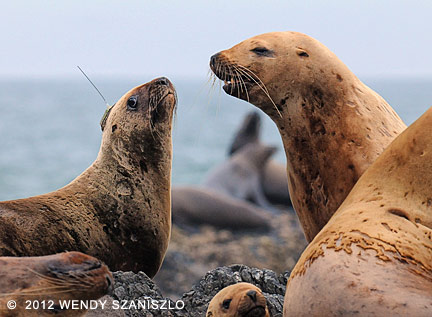
A marine mammal biologist (who also volunteers with the British Columbia Marine Mammal Stranding Response Network) was doing routine re-sights of branded animals when she noticed Mojo with his satellite tag on a very busy and popular Steller haulout site, Long Beach Rocks. This is one of a number of haulouts in and adjacent to the Pacific Rim National Park. Long Beach is considered a year round haulout for Stellers. Biologist Wendy Szaniszlo conducted a 3-yr study of the seasonal abundance and distribution of sea lions in the park preserve. Stellers are considered a Species of Special Concern under Canada’s Species at Risk Act. Wendy reports that Mojo was observed in the “middle of the action”, which means he seems to have adapted well to life back in the wild.
You can follow Mojo’s travels on SeaDoc Society’s website and receive almost daily updates on his location. Since this photo was taken, he is on the move once again and headed further north, well beyond Vancouver Island into Queen Charlotte Sound. As you can see from the photo, this is the time of year when sea lions molt their fur. Soon, Mojo’s glued-on tag will fall off as he sheds his old coat and grows a brand new silky one and transmissions will cease. Many thanks to Wendy for sharing this photo! Read more about Mojo’s story here.
PUPDATE: 7/3/12
A satellite picked up a ping from Mojo’s transmitter yesterday and he has made it to Haida Gwaii (formerly known as the Queen Charlotte Islands), which consists of about 150 islands off the coast of British Columbia. More specifically, his location appears to be Gwaii Hanas National Park Reserve.
Mojo has travelled 962 km (over 598 miles) since released back to the wild on May 29th.
Satellite Sandy cruising the San Juan Islands
Mar/11/12 09:54 AM
The seal pup that Seal Sitters MMSN rescued from the beach in August is now cruising the San Juans. We know this because after a lengthy rehab at PAWS Wildlife Center, Sandy was fitted with a satellite tag and released at a harbor seal haul out south of Tacoma. She has been moving all over the region - Olympia, Shelton, Vashon Island, 3 Tree Point, West Seattle, Richmond Beach and now the northern islands. You can follow Sandy’s lengthy travels on SeaDoc Society’s dedicated webpage and receive email alerts when a satellite picks up her signal. Her movements enable biologists to learn more about seal pup behavior. The glued-on tag will fall off when Sandy sheds her fur coat in a few months.
PUPDATE 3/12
The latest satellite hits show that Sandy has opted to head back south and was pinged at the northeast tip of the Olympic Peninsula. This is a bit of a relief since we wonder if she is able to tell the difference between the vocalizations of the transient orcas who eat seals and that of the residents who prefer salmon. With no mom to have taught her the ins and outs of life in the wild, she is trying to figure things out on her on.
PUPDATE 3/12
The latest satellite hits show that Sandy has opted to head back south and was pinged at the northeast tip of the Olympic Peninsula. This is a bit of a relief since we wonder if she is able to tell the difference between the vocalizations of the transient orcas who eat seals and that of the residents who prefer salmon. With no mom to have taught her the ins and outs of life in the wild, she is trying to figure things out on her on.
Seal pups galore in West Seattle
Mar/08/12 07:58 AM
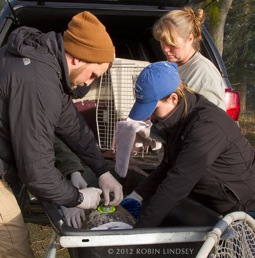
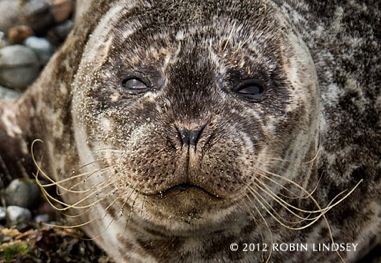
Sandy the satellite-tagged pup near Vashon Island
Feb/21/12 06:47 AM
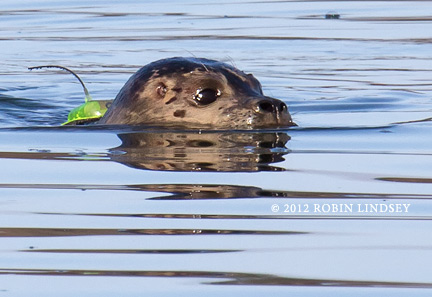
Keep your eyes peeled for a little seal pup with a yellow transmitter on her back. If you see her, please keep your distance and call our hotline @ 206-905-7325 (SEAL). Her movements are being studied by biologists and will give tremendous insight into the behavior of rehabilitated pups as they try to adapt to life back in the wild. SeaDoc has a web page devoted to Sandy here and you can receive email updates as to her locations and cheer her on. It is very exciting for volunteers and the public to be able to follow Sandy’s progress and see how well she is doing back in the Salish Sea.
Satellite Sandy spreads her wings in the Salish Sea
Feb/16/12 09:47 PM
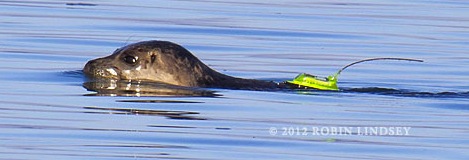
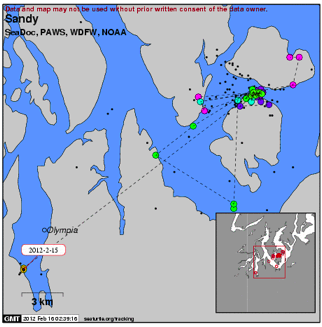
You can follow Sandy’s travels on SeaDoc’s website. In fact, you can even get an email alert when passing satellites pick up her signal. Check out Sandy’s dedicated page here. And, if you happen across a log boom, grab your binocs and see if there is a seal or two catching some zzzz’s - maybe you’ll even see Sandy with her fancy yellow hat!
Seal pup Sandy released back into the wild
Jan/31/12 05:52 PM

Sandy’s movements will provide ground-breaking information for biologists. She can be tracked by the public as well on SeaDoc Society’s website, which has a web page dedicated to her, showing a map of her cruising around South Puget Sound. In the photo above, Sandy swims in the wild with her new satellite hat. Tracking this animal would not be possible without the collaboration of several network groups which include: Seal Sitters MMSN, PAWS Wildlife Center, WDFW Marine Mammal Investigations, SeaDoc Society and NOAA’s Protected Resources Division.
PUPDATE: Feb 2/2012
We have had some folks with concerns that the satellite tag is somehow harmful for Sandy. The tag is applied with glue to Sandy’s pelt and will fall off when she sheds her fur during molting season in a few months. Most likely, the tag will fall off before then; however, in the interim, the satellite tracking will provide researchers with insights into foraging patterns, distances travelled by weaned pups and health and mortality data. This research will help other seal pups in the future.
Rehabbed pup Sandy due for release
Jan/19/12 12:26 PM
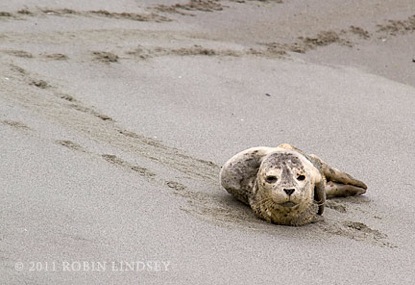
Sandy will be fitted with a satellite tag. This will provide valuable information to biologists and the hope is that the public will be able to track her movements via the internet as well. Her release had been planned for tomorrow, however, due to snow and ice conditions, it will be rescheduled. Please check back for photos of her release to a South Puget Sound haul out site and information about potential website monitoring. It would be a thrill to be able to follow Sandy’s progress back home in the sea.
Seal pup Sandy thriving in rehab at PAWS
Oct/02/11 07:56 AM
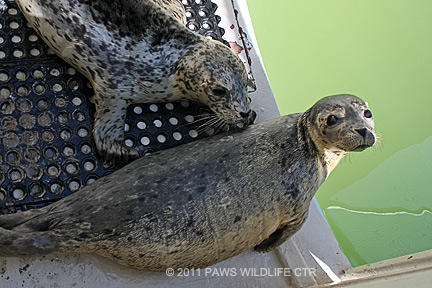
Seal pup Sandy doing well in rehab
Aug/19/11 07:20 PM
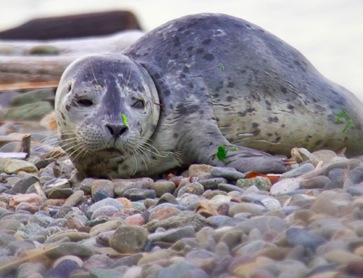
Sandy is shown here in the light of early evening on the pebbled beach north of the Water Taxi landing. A seal’s fur looks very different when wet or dry (see dry photo in story below), often making identification difficult. For this reason we try to get detailed photos of spots and markings which enables us to track an animal if there are health concerns. In Sandy’s case, she had very defined markings on her left foreflipper and around the eyes, so we were easily able to identify her when she hauled out on a different beach.
PUPDATE 8/22/11 PAWS reports that Sandy is still doing well and taking whole fish.
Rehabbed seal pups behave differently than wild pups
Aug/04/11 07:57 AM
Each year, seal pups are taken for rehabilitation to PAWS in Lynnwood and Wolf Hollow on San Juan Island, the two excellent, but limited resources for our region. Pups are removed from the wild due to human interference, endangerment or compromised health. In a Seattle Times article by Lynda Mapes published yesterday, a study being conducted by SeaDoc Society shows that rehabbed seal pups behave quite differently than those who have lived solely in the wild, in particular their foraging patterns - evidence that a pup should always remain with his mom whenever possible to learn the skills to survive. The decision to remove a seal pup from the beach is one that is weighed heavily by stranding experts. Read the article here.
Many thanks to Lynda for keeping seal pups in the forefront of the news and for giving Seal Sitters a nice mention. Lynda has been a great ally of our network over the past few years.
Many thanks to Lynda for keeping seal pups in the forefront of the news and for giving Seal Sitters a nice mention. Lynda has been a great ally of our network over the past few years.
Seal pup Storm finally returns home to the Salish Sea
Nov/17/10 06:32 PM

When Seal Sitters rescued Storm from the beach on Labor Day, September 6th, she was estimated to be only a few weeks old, weighed a mere 17.7 lbs and was a length of 33 inches. Yesterday when released, she weighed 62 lbs and was 37 inches - only 4 inches longer, but about 45 lbs heavier! Storm is truly a beautiful blubberball who has been given a second chance at life. To have been a part of saving her life and helping Storm return home cannot be put into words.
To read all posts about Storm, please click on the tag below.
Storm to be released back into the wild next week
Nov/11/10 06:48 PM

We thank PAWS for their monumental effort to restore her back to health. Our little bag-o-bones pup is now a true blubberball.
Storm fattens up at PAWS
Oct/29/10 09:09 PM
 Storm is one fat and happy blubberball at PAWS. It is shocking to compare the photos of Storm on the beach at Lincoln Park to her rotund self these days. The above photo at left was taken on September 5th and Seal Sitters rescued her the next morning. For two full weeks or more at PAWS, it was uncertain if she would survive. Thanks to Kevin, PAWS’ naturalist, for sending a recent photo of her in the big pool. She is scheduled for release sometime soon and we will keep you posted with updates.
Storm is one fat and happy blubberball at PAWS. It is shocking to compare the photos of Storm on the beach at Lincoln Park to her rotund self these days. The above photo at left was taken on September 5th and Seal Sitters rescued her the next morning. For two full weeks or more at PAWS, it was uncertain if she would survive. Thanks to Kevin, PAWS’ naturalist, for sending a recent photo of her in the big pool. She is scheduled for release sometime soon and we will keep you posted with updates.Help Storm by donating to PAWS
Oct/14/10 07:41 PM
Storm is thriving in rehab at PAWS, but it is an extremely costly endeavor to rehab a seal pup - a very labor and food intensive process. We recently were able to get some video footage of Storm swimming in her big pool and being fed a tasty lunch of capelin. It is estimated that Storm’s diet runs about $350 per month. Most seal pups like herring, but Storm has an appetite for capelin, of which she consumes about 11 pounds a day! Storm will continue to grow stronger at PAWS for at least another 4-6 weeks - until she has put on a sufficient blubber store to help her survive upon release back into the wild.
Please make a donation to PAWS (designate “in honor of an animal” - West Seattle seal pup Storm) today and help pay for Storm’s gourmet meals. PAWS relies solely on donations from the public to continue their work. It is estimated that the rehab of one seal pup is approximately $10,000. If you donate, please email us and we’ll let PAWS know our readers made donations. You can also mail a check to: PAWS Wildlife Center, PO Box 1037, Lynnwood, WA 98046 (please indicate on the check that it is to go to the Wildlife Center, seal rehab).
PAWS goes the extra mile to make sure that seal pups are not given too much human exposure while in rehab so that they are not habituated to people upon release. Storm was not allowed to see us and our camera was hoisted over the top of her pool. It was very exciting to see how fat and vibrant she has become.
Storm doing great in rehab
Sep/30/10 09:16 PM
Seal pup, Storm, who was rescued from a Lincoln Park beach on Labor Day, is flourishingt at PAWS. She is now chasing and catching live fish in her large pool. So, the prognosis for a successful rehab and release is very good. Thanks to the dedicated staff at PAWS!
Golden Gardens pup, Sparky, loses battle at PAWS
Sep/20/10 07:45 PM
Seal Sitters learned this morning that Sparky (the female pup we helped rescue from a Ballard beach) died overnight at PAWS. Sparky had been struggling to survive. Please check back tomorrow for more details along with an update on the West Seattle pup, Storm (taken to PAWS on Labor Day). As of late last week, Storm was being fed solid food and had good body weight, but some health complications.
Pupdate: Storm and Sparky still holding their own at PAWS
Sep/16/10 09:40 PM

Storm has good body weight and is still feisty and alert. However, her blood numbers were quite high in some areas. An ultrasound was performed on her yesterday and it revealed that she has an inflamed gall bladder and possibly appendicitis or pancreatitis. The pup that was illegally removed from the outer coast beach, taken to a hotel and then eventually to PAWS also had an inflamed gall bladder. That pup was treated and successfully rehabbed and released this month. Rehabbers do not know what is the cause of the inflammation. Storm has been put on a series of medications to treat her ailments. She has gone from being tube fed a “herring/salmon shake” to solid food consisting of dead herring. Pups have to be force fed the herring until they eventually will chase and eat live fish that is put into their pool. It can be a tedious and lengthy process to get them oriented to feeding themselves.
Sparky has good blood levels, but just can’t seem to put on weight so there is some major concern there. She is still suffering from chronic diarrhea and remains on a fish-shake diet.
Storm and Sparky move to the outside pools at PAWS
Sep/11/10 08:12 PM
Storm (West Seattle pup) and Sparky (Ballard pup) have each been moved to the outside pools at PAWS. The rehab staff there is “cautiously optimistic” about their chances. There is a bit of concern that the pups are not gaining weight, so they were being tube fed today. However, they are both alert and “feisty” and Storm is reportedly one bitey little girl. Once the pups have completed their quarantine they will be put in the same pool - let’s hope they will soon be doing the backstroke together!
Pupdate: seal pup Storm wins first round at PAWS
Sep/07/10 01:37 PM
We received a “pupdate” on Storm, our little pup that was taken to PAWS yesterday afternoon. According to PAWS, Storm is a feisty female - just like the team of women she is named after! She gained quite a bit of weight overnight, but most of that is from being hydrated with fluids and she now weighs 18.7 lbs. Additionally, Storm has quite a few wounds on her, but the good news is none are infected. The most serious wound is a pretty severe one to her right rear flipper. She is being given a round of antibiotics and nutritional support. She is not out of danger, but Seal Sitters volunteers are greatly encouraged.
If Storm doesn’t show signs of the highly contagious disease Brucella, she will be able join the female pup, Sparky, that Seal Sitters helped rescue on Saturday morning. The two pups will go through their rehab together. Many, many thanks to PAWS as always for their incredible work! Please make a donation to PAWS designated to defray the extreme costs of rehabbing seals. Stay tuned for more pupdates on these two gorgeous pups.
Pupdate
9/8/10 7:35
Both Storm and Sparky are alert and feisty this morning, but are battling a bit of diarrhea. Rehabilitators are giving them subcutaneous fluids to keep them hydrated while they adjust to their new food.
If Storm doesn’t show signs of the highly contagious disease Brucella, she will be able join the female pup, Sparky, that Seal Sitters helped rescue on Saturday morning. The two pups will go through their rehab together. Many, many thanks to PAWS as always for their incredible work! Please make a donation to PAWS designated to defray the extreme costs of rehabbing seals. Stay tuned for more pupdates on these two gorgeous pups.
Pupdate
9/8/10 7:35
Both Storm and Sparky are alert and feisty this morning, but are battling a bit of diarrhea. Rehabilitators are giving them subcutaneous fluids to keep them hydrated while they adjust to their new food.
Golden Gardens pup taken to PAWS
Sep/04/10 02:23 PM

This morning Seal Sitters received a report that a group of people had been seen kicking sand on this pup around 8pm last night. If you see a marine mammal being harrassed or injured it is a matter for law enforcement. Call the NOAA Enforcement Hotline @ 1-800-853-1964 (monitored 24 hrs a day) and tell them an animal is being harmed. If the animal or the public is in imminent danger, CALL 911. NOAA Enforcement is not an immediate response team, as there are limited officers in the Pacific Northwest. However, the line is answered 24 hours a day and a harassment should be reported to them immediately. They are an investigative unit and will fine and prosecute violators of the Marine Mammal Protection Act with the proper evidence: violator’s name, photo, or auto license plate number. Do not put yourself at risk to obtain this information. If you need a law enforcement presence because the public or animal is in imminent danger, call 911.
Update 9/5/10. Sparky is doing fine at PAWS today, so keep her in your thoughts.
Update 9/6/10. PAWS has provided photos of Sparky who continues to improve.
